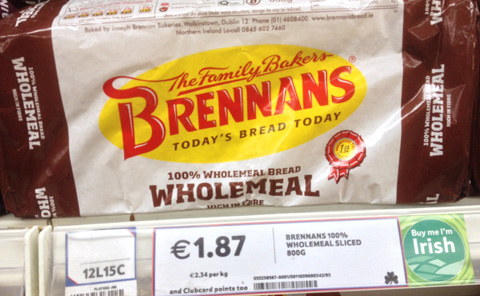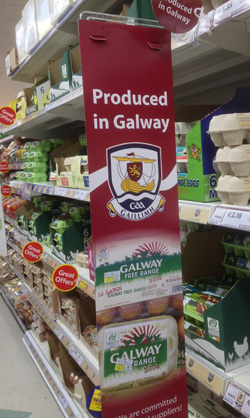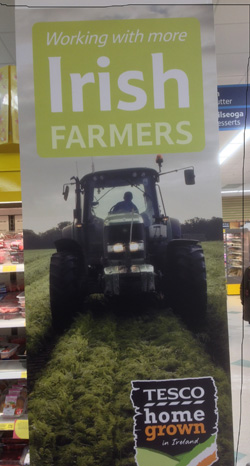 Letters from Ireland
Letters from Ireland
Stephen J. Scanlan, Fulbright Scholar
National University of Ireland Galway
Suitable for vegetarians.
Oh, how I love to hear, or rather see, these words. And not just because I am a vegetarian and that it makes grocery purchases a bit easier.
Rather, the words symbolize greater transparency in food labeling practices in Ireland and the European Union than in the United States. One that tends to provide consumers with better information to enable more enlightened decisions regarding food purchases and related health issues. I have been able to explore this issue in connection with the sustainability research I am conducting as a Fulbright Scholar.
 So just what is on the labels and how do they differ? Much of the information is the same as the United States, but the additional details and information are what make a difference.
So just what is on the labels and how do they differ? Much of the information is the same as the United States, but the additional details and information are what make a difference.
Labels in both countries report the nutritional content of the food, with the United States using the “recommended daily allowance” (RDA) while Ireland uses the “guideline daily amounts” (GDA) developed in the United Kingdom. The purpose is to provide the consumer with important information regarding the calorie content of the food, the amount of sugars, fat, saturated fat, and salt, as well as detailed vitamin and mineral content. In both places the nutritional content is based on a standard diet of what a healthy adult should consume.
And of course, labels in both places also contain the ingredients of the food. These are listed in descending order, with the ingredient making up the largest proportion of the food coming first.
This is where some interesting differences are revealed. Using a guideline referred to as the “quantitative ingredient declaration” (or QUID), labels in Ireland actually reveal the percentage of the product that the largest ingredients make up or are in the name of the product. For example, just what percentage of the “whole grain” breakfast cereal or bread is the product comprised of? How much chicken is actually in one’s “chicken pot pie”?
Perusing the labels, I am typically surprised at how little of certain things are in the foods being marketed—especially if the ingredient is in the name of the product. The QUID percentages really make this clear and can help consumers make more informed decisions while encouraging transparency.
 Now as one can imagine there are layers of rules for this and of course exemptions of all kinds. (See the European Commission’s food labeling page or the Ireland Food Safety Authority for more details.) For example, the percentage is not required for all of the ingredients, and products containing a combination of things such as “vegetable soup” do not have to break down every vegetable—though “vegetable soup with lentils and beef” would disclose the amounts for these latter, specific items emphasized in the name of the product.
Now as one can imagine there are layers of rules for this and of course exemptions of all kinds. (See the European Commission’s food labeling page or the Ireland Food Safety Authority for more details.) For example, the percentage is not required for all of the ingredients, and products containing a combination of things such as “vegetable soup” do not have to break down every vegetable—though “vegetable soup with lentils and beef” would disclose the amounts for these latter, specific items emphasized in the name of the product.
This all comes from the desire to understand the health benefits of the food we consume and various food safety standards. Extending this, food labels are more open with regard to revealing a number of connected health considerations of interest to the consumer. This trend is of growing interest in the United States, but the E.U. seems to be a step or two ahead.
Thus, allergen information, notation for certified organic foods, indications for gluten-free, highlights for low glycemic index foods, and even more information pertaining to the potential for recycling the packaging materials are on the labels when compared to the U.S.
And what about genetically modified organisms (GMOs)? Given the European Union’s much stricter regulations pertaining to GMOs and requirements that these be noted on packaging, their use is rare for fear of consumer backlash and avoidance of the product. Thus, Mars does not use artificial dyes in its M&Ms in Europe to avoid the GMO label and associated stigma and health concerns. (See related NPR News story.) Discussion of GMO labeling is not absent in the United States and in fact is beginning to pick up. It just is not what it is here in Europe where consumers are much more distrusting and suspicious of their unknown effects.
Finally, point of origin is another important element of the food labeling system as well.
As in the United States, knowing “where one’s food comes from” is of great interest, as is support for buying foods of local or national origin or cooking with local ingredients. Labels here help one surmise this, going as far as to not just say where a product was made but also that it was produced with local and/or imported ingredients. Point of origin has become particularly important in Ireland in the last few years, and at both local and national levels Irish farms and food production have been promoted by government initiatives, environmental and food organizations, business groups, think tanks, and the country’s national food board.
A cooperative group of Irish brands has even taken labeling a step further to add an economic emphasis to food labeling with its “Love Irish Food” campaign. The Love Irish Food logo on a label guarantees that the product was manufactured or processed in the Republic of Ireland with ingredients from Ireland when available. Of course, this latter point is particularly important with regard to explaining Barry’s black tea or Sqeez brand orange juice. I am pretty sure there is not a black tea plantation or orange grove anywhere on Ireland’s soil.
Finally, all of this of course is very political, and any discussion of food labeling can be quite contentious.
In a political economy of food dominated by agribusiness and food production and distribution companies that have large interests at stake, anything perceived to potentially cut into their profit margin will certainly be challenged. Hence the over $139.2 million that agribusiness spent on lobbying in the United States last year or the additional $24.6 million it spent on political action committees in the 2012 election cycle as reported by the Center for Responsive Politics. Influencing Congress and working closely with the U.S. Department of Agriculture to ensure its interests are heard is a component of a food industry of which labeling is only a part of the debate.
And despite the more progressive approach to labeling, Europe is not exempt from the politics and power of the food lobby.
The European Commission is currently debating the possibility of implementing a new “traffic light” system of food labeling—a much more visual and easily understood representation of the food which consumers actually prefer for its simplicity and even greater transparency. Thus, with regard to the fat content of a product, green would mean healthy, amber would elicit caution, and red would mean avoid. The Corporate Europe Observatory, an industry watchdog group, is reporting that the food industry has spent a billion euros fighting this and is probably going to win in the vote on this that is expected to come soon. This should probably not be surprising given that Ireland and the rest of Europe is part of the same global political economy of food that multi-national corporations dominate.
It is therefore important to keep in mind that although transparency in food labeling is beneficial for the consumer, food labels do not necessarily mean the healthiest or best-tasting food.
Whether in the United States or Ireland, the best foods are what are not labeled to begin with: the artisan cheese, pan of bread, herbal tea, or fresh produce from the local farmer’s market, food stand, or family-owned shop, CSA, or co-operative. Food whose contents are obvious and its point of origin is “just down the road.”
Take for example the honey I recently purchased at the English Market in Cork City: The label was handwritten “100% Honey, West Cork.”
Good stuff!
Dr. Stephen J. Scanlan is Associate Professor of Sociology at Ohio University’s College of Arts & Sciences.
This column is not an official Fulbright Program communication. The views expressed on this site are entirely those of its author, Stephen J. Scanlan, and do not represent the views of the Fulbright Program, the U.S. Department of State or any of its partner organizations.



















Comments